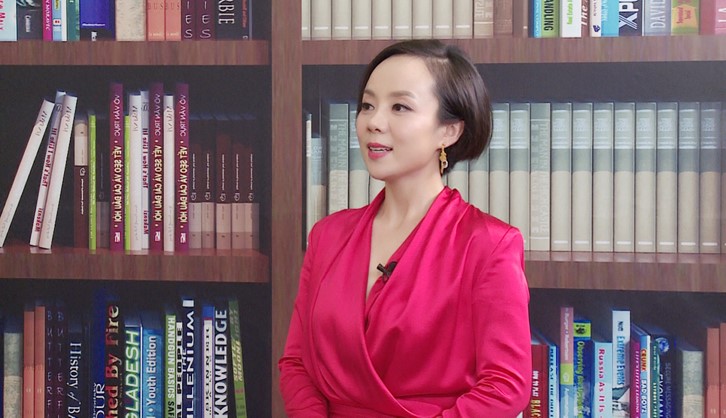
当前课程知识点:Diagnostics in Chinese Medicine > Week 2 Basic Theory of Chinese Medicine 2:Zang-Fu Theory > 2.4 Lung > 2.4 Lung
返回《Diagnostics in Chinese Medicine》慕课在线视频课程列表
返回《Diagnostics in Chinese Medicine》慕课在线视频列表
同学们好
我们继续学习五脏肺的生理功能和病理变化
肺在脏腑中位置是最高 所以它称为华盖
肺叶比较娇嫩 不耐寒热
所以又称为娇脏
肺主要从两个方面来学习
一是肺的生理和病理
二是肺的联属功能
下面我们来学习肺的主要的生理功能和病理变化
肺的主要生理功能是 肺主气
司呼吸
肺主气 有两个含义
第一个含义是指肺主呼吸之气
肺是气体交换的场所
中医认识的肺和西医解剖上的肺是一致的
肺通过呼吸
从自然界中吸入清气 也就是氧气
呼出体内的浊气 也就是二氧化碳
实现机体与外界的气体交换 维持人的生命活动
如果肺受邪而功能异常
就可以表现出咳嗽 气喘
以及呼吸不利等
呼吸系统的症状
我们把这个咳嗽 气喘称为肺的必有症状
或者是肺的定位症状
肺主气的第二个含义是指
肺主一身之气
是指肺有生成宗气
并调节全身气机的作用
首先体现在宗气的生成
宗气是由肺吸入的自然界清气与
脾胃运化的水谷精气结合而成的
其次 肺主一身之气还体现在
对全身气机的调节的作用
这个调节主要是通过肺的呼吸运动
来调节气的升降出入的运动
肺主一身之气的功能出现异常
就会表现出气短 声低 乏力
以及全身气机升降失常的表现
肺的第二个生理功能 就是主宣发和肃降
这个宣发和肃降仍然是肺主呼吸之气的功能的体现
宣发是指的向上升宣 向外布散
肃降是指的向内 向下清肃通降
宣发有两层含义 其一是通过呼吸
排出体内的浊气 也就是二氧化碳
其二是将体内的卫气
津液 水谷精微
这些都是由脾气运化而来的营养物质
通过肺 宣发 布散头面 周身
外达于皮毛 营养我们的肌肤
肃降的功能主要体现在三个方面
第一是吸入自然界的清气
这是一个降的过程
第二个将吸入的清气
和脾转输来的津液和水谷精微向下布散到全身
第三个就是
肃清肺和呼吸道内的异物
以保持呼吸道的洁净
只有宣发和肃降正常
我们的呼吸功能就正常
营养输布才能够正常
肺和呼吸道的异物才能够排出
保持呼吸道洁净
而如果宣发肃降失常
就会表现出肺气不宣
或者是肺失肃降的病变
临床以咳嗽 咳痰
喘息 胸闷 胸痛为主要表现
我们特别把肺宣发卫气提出来给同学们讲一下
卫气来源于脾胃运化的水谷精微
它是由肺气输布到体表肌肤腠理
这里面的肌肤腠理 就是指我们的毛孔
卫气分布到肌肤之后有三个作用
第一个就是 温煦脏腑 润泽皮毛
第二个就是 护卫肌表 抗御外邪
第三个就是调节控制肌腠的开阖和汗液的排泄
所以《灵枢》有言
“卫气者,所以温分肉,
充皮毛,肥腠理,司开阖者也。”
如果肺气充足 卫气也很充足
我们的皮毛就会润泽
我们就能够抵抗外邪
不容易受到外界的侵犯
我们的汗就能够受到控制 不会随便出汗
但是如果肺气虚弱 卫气不足 卫外不固
就可能不能够温煦我们的皮毛
体表就会觉得怕风吹
风一吹就会觉得特别的冷 同时风一吹
外邪吹向人体
而肺气虚弱 卫气又不固
不能抵抗外邪 就会容易出现受风感冒
而且
由于卫气在肌肤腠理
如果毛孔中的卫气减少 不能够控制汗液
就会导致汗多
如果我们把肌肤腠理比喻成城墙的话
卫气就相当于城门中的卫兵 若卫兵不足
城内的居民 也就是我们人体的津液
就可能随便的流出去 表现为多汗
如果卫兵不足
且城门又开启着
城墙外的敌人 比如风邪
就可能会进来
人就会容易出现受风感冒
所以卫气不足的时候 人容易出汗
特别容易感冒 畏风 怕冷
肺的第三个功能就是肺主通调水道
这个通调水道的功能 与肺的呼吸功能有关
它与肺的宣发和肃降的运动趋势有着密切的关系
肺主通调水道的通是指的疏通
调是指的调节
通调水道是指
肺的宣发和肃降 能够对体内的水液的输布
运行和排泄起着疏通和调节的作用
肺是如何疏通 调节人体水分的呢
首先 肺通过宣发
将津液和水谷精微布散到周身
而且肺气 管理人体的腠理
也就是毛孔的开合
它可以调节汗液的排泄
肺通过宣发可以将体内的水分变成水汽
通过呼吸排出体外
也可以通过体表毛孔
把津液变成汗液排出体外
这就是肺的宣发功能的体现
同时 肺通过肃降
可以将体内的水液不断地向下输送
经过肾和膀胱气化
生成尿液而排出体外
如果肺的通调水道的功能异常
则水在体内的输布排泄也会出现障碍
就会表现出小便不利 水肿
或者是痰饮等等症状
肺主通调水道也会出现水肿
我们在讲脾的时候
也知道
脾如果出现病变
不能够运化水液 也可以出现水肿
不过脾的水肿 通常是因为脾虚
不能够运化水谷精微而引起的水肿
它的前提是脾虚气血不足 营养不良
表现出来的水肿
而肺引起的水肿 通常会与外感病变有关系
感受外邪 侵犯肺卫
肺的宣发和肃降功能失常
引起水液代谢失常 就会出现水肿
所以肺引起的水肿和脾虚引起的水肿是不一样的
肺的生理功能 最终概括为
朝百脉 主治节
朝是指聚会
百脉是指人体全身血脉
它是指全身的血液
都要通过经脉而聚会于肺
通过肺的呼吸 进行气体交换
然后再输布到全身
所以血的运行 有赖于气的推动
随气的升降出入而运行到全身
肺主一身之气 可以帮助心脏
推动血液运行
所以我们称为肺气可以助心行血
治节是指治理调节
肺主治理调节 是指肺具有治理调节
肺的呼吸和全身气血津液运行的作用
它主要体现在
肺的呼吸功能 可以调节呼吸运动
可以调节全身的气的运动
可以治理血液的运行以及津液的代谢
由此我们可以看出肺主治节
其实是肺主气的生理功能的高度的概括
以上是我们讲到的肺的生理功能和相对应的病理变化
下面我们来看一看肺的联属功能
还是从四个方面来学习
首先
肺在志为悲忧
是指肺的功能与悲忧情绪密切相关
悲忧均为非良性刺激情绪的一种反映
如果悲忧过度 会耗伤肺气
使肺气虚弱
另外 肺虚的人
则对外来不良的刺激的耐受力也会降低
容易产生悲忧的情绪
比如林黛玉
她的肺气就不足
所以也容易悲伤
而悲伤 就更加耗损肺气
这是一个恶性循环
其次 肺在体合皮 其华在毛
是指
肺主气 具有宣发卫气 输精于皮肤和毛发的功能
肺气充足 可以使我们的皮肤致密
毛发光泽 抗邪有力
如果肺气虚弱 卫外不固
皮毛枯槁 抗邪无力
就可以表现出多汗和容易感冒
肺开窍于鼻
是指鼻的通气和嗅觉 与肺气的宣发功能关系密切
当肺气正常 呼吸就正常
鼻窍通利 呼吸平稳 嗅觉也会很灵敏
当肺失宣发 鼻塞不通 呼吸不利 嗅觉也会失去灵敏
最后我们来总结一下肺的生理功能 就是肺主气司呼吸
而肺主呼吸之气 它的运动趋势 有宣发和肃降两种
宣发和肃降
不仅可以把营养物质运送到全身
也可以使我们人体体内的水分
能够得到输布和代谢
所以肺的生理功能 主要是主呼吸之气
而宣发肃降 通调水道
都是与呼吸之气有密切关系
由此我们可以看出
肺如果出现病变 它的必有症状
一定是肺主呼吸之气出现异常
表现出咳嗽 气喘
所以我们把咳嗽 气喘称为肺病的定位症状
或者我们称为肺病的必有症状
以上是我们学习的肺的生理功能和病理变化
以及肺的定位症状
这节课就讲到这里
-Introductory remark
--QQ groups、WeChat public account
-Introduction
--【Discussion 1】Why do you want to take this course?
-Unit test for Introduction
-1.1 Yin-yang theory
-1.2 The theory of five elements
--1.2.1 The theory of five elements
--1.2.2 Application of the theory of five elements
-Frequently Asked Questions
-Unit test for week 1
-2.0 Outline
--【Discussion 2】How to understand the holistic view centered on the Zang Fu theory?
-2.1 Liver
--【Discussion 3】Why is repose more important than vigorous exercise in recuperation for patients with
-2.2 Heart
-2.3 Spleen
-2.4 Lung
--2.4 Lung
-2.5 Kidney
-2.6 Six fu organs
-Frequently Asked Questions
-Unit test for week 2
-3.1 Qi
--3.1 Qi
-3.2 Blood
-3.3 Body fluid
-3.4 The relationship of qi, blood and body fluid
--3.4 The relationship of qi, blood and body fluid
--【Discussion 4】A discussion about the theory of qi, blood and body fluid
-Frequently Asked Questions
-Unit test for week 3
-4.0 Outline
-4.1 Six exogenous factors
--4.1.2 Nature and pathogenicity of wind and cold
--4.1.3 Nature and pathogenicity of summer heat and damp
--4.1.4 Nature and pathogenicity of dryness and fire
-4.2 Etiology of visceral impairment
--4.2 Etiology of visceral impairment
-Frequently Asked Questions
-Unit test for week 4
-5.0 Outline of inquiry
--【Discussion 5】If you were a patient, how would you describe your condition to your doctor first?
-5.1 Inquiry of Chills and fever
--5.1.1 Chills and fever(Aversion to cold with fever)
--5.1.2 Chills and fever(Chills without fever)
--5.1.3 Chills and fever(Fever without chills)
--5.1.4 Chills and fever(Alternative chills and fever)
--【Discussion 6】How to understand "if you have clinical manifestations of cold, that is exterior syndr
-5.2 Inquiry of perspiration
-Frequently Asked Questions
-Unit test for week 5
-5.3 Inquiring of pain
--【Discussion 7】How to understand "stagnation leading to pain and innourish leading to pain"?
-5.4 Inquiring of head, body, thorax and abdomen
--5.4 Inquiring of head, body, thorax and abdomen
-5.5 Inquiring of ears and eyes
--5.5 Inquiring of ears and eyes
-5.6 Inquiring of sleep
-5.7 Inquiring of food and drink, appetite and taste
--5.7 Inquiring of food and drink, appetite and taste
-5.8 Inquiring of defecation and urination
--5.8.1 Inquiring of defecation
--5.8.2 Inquiring of urination
-5.9 Inquiring of infantile and women's disease
--5.9 Inquiring of infantile and women's disease
-Unit test for week 6
-6.0 Outline of Observation
--【Discussion 8】Please use the whole body inspection (including the expression, complexion and figure)
-6.1.1 Observation of vitality
--6.1.1 Observation of vitality
-6.1.2 Observation of the color
--6.1.2.1 The content, principles of inspection of the color
--6.1.2.2 Indication of diseases by five colors
--【Discussion 9】How do you understand the normal complexion of a normal people?
-6.1.3 Observation of the appearance
--6.1.3 Observation of the appearance
-6.1.4 Observation of figure and posture
--6.1.4 Observation of figure and posture
-Unit test for week 7
-6.2.1 Observation of head and face
--6.2.1 Observation of head and face
-6.2.2 Observation of five sensory organs
--6.2.2.1Observation of five sensory organs(observation of eyes,ears,nose)
--6.2.2.2Observation of five sensory organs(observation of lips,teeth and gums,throat)
-6.2.3 Observation of body
-6.2.4 Observation of limbs
-6.2.5 Observation of two lower orifices
--6.2.5 Observation of two lower orifices
-6.2.6 Observation of skin
-6.3 Observation of excreta
-6.4 Observation of infantile fingerprints
--6.4 Observation of infantile fingerprints
-Frequently Asked Questions
-Unit test for week 8
-7.1 Outline of tongue inspection
--7.1.1 The morphology and structure of the tongue
--7.1.2 The principle of tongue examination
--7.1.3 The method and precaution of tongue examination
--7.1.4 The content of tongue examination, normal tongue
-7.2 Inspection of tongue structure
--7.2.1 Observe the color of tongue
--7.2.2 Observe the shape of tongue
--7.2.3 Observe the states of tongue
--7.2.4 Observation of sublingual vein
-7.3 Observation of tongue coating
--7.3.1 Observation of coating texture
--7.3.2 Observe the color of coating
-7.4 Clinical significance of tongue diagnosis
--7.4 Clinical significance of tongue diagnosis
--【Discussion 10】Why to observe the tongue can be used to diagnose disease?
-Unit test for week 9
-8.1 The principle of pulse examination
--8.1 The principle of pulse examination
-8.2 The regions and methods of pulse examination
--8.2 The regions and methods of pulse examination
-8.3 The elements of pulse examination and the normal pulse
--8.3 The elements of pulse examination and the normal pulse
-8.4 Characteristics and significance of pulse
--8.4.1 Superficial pulse, deep pulse, slow pulse, rapid pulse
--8.4.2 Surging pulse, thin pulse, long pulse, short pulse
--8.4.3 Feeble pulse, forceful pulse, slippery pulse, uneven
--8.4.4 Taut pulse, tense pulse,soggy pulse, moderate pulse
--8.4.5 Knotted, slow-regular-intermittent, irregularly abrupt
-8.5 Similar pulse, concurrent pulse, pulse indicating deterioration of visceral qi۞
--8.5 Similar pulse, concurrent pulse, pulse indicating deterioration of visceral qi۞
--【Discussion 11】Why is complex pulse more common than single-factor pulse?
-8.6 Women’s pulse, children’s pulse
--8.6 Women’s pulse, children’s pulse
-8.7 The clinical significance of pulse diagnosis
--8.7 The clinical significance of pulse diagnosis
-Unit test for week 10
-9.1 Listening
-9.2.1 Abnormal sound
-9.2.2 Abnormal language
-9.2.3 Respiratory abnormality
--9.2.3 Respiratory abnormality
-9.2.4 Cough
--【Discussion 12】How to observe the patient's cough sound and sputum changes to determine whether the
-9.2.5 Abnormal sounds of the stomach and intestines
--9.2.5 Abnormal sounds of the stomach and intestines
-9.3 Smelling
--【Discussion 13】How to diagnose by smelling?
-Unit test for week 11
-10.1 The method, meaning and precautions of palpation
--10.1 The method, meaning and precautions of palpation
-10.2 Contents of palpation
--10.2.1 Palpating chest and hypochondrium
--10.2.2 Palpating stomach and abdomen
--10.2.4 Palpating hands and feet, palpating acupoints
--【Discussion 14】How to determine whether external or internal injuries?
-Unit test for week 12
-Conclusion
-Final Exam
--Final Exam

